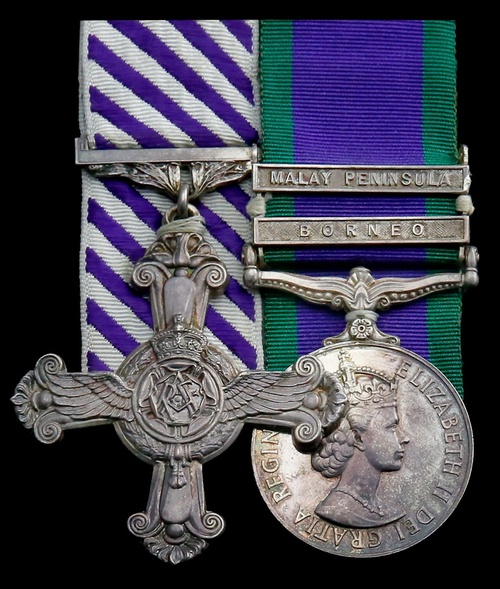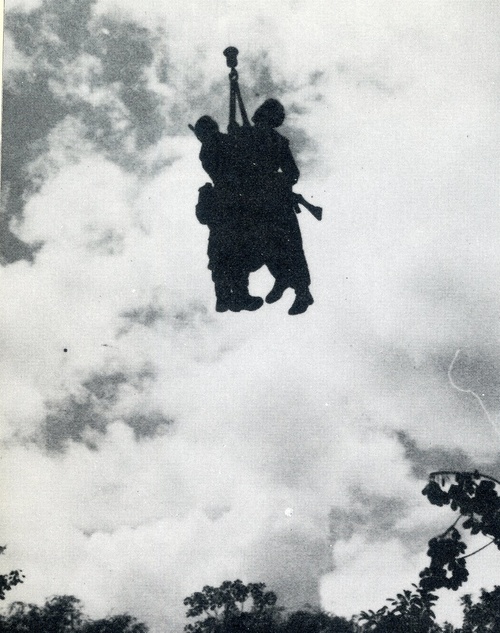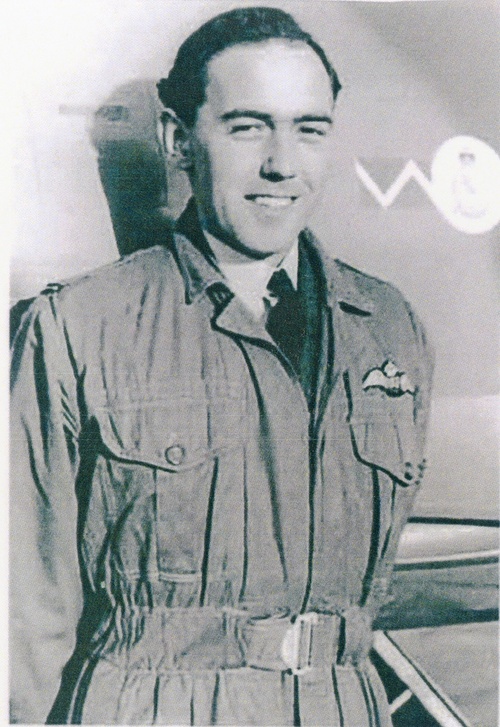Auction: 17003 - Orders, Decorations and Medals
Lot: 723
'The Army's Borneo strategy depended entirely on the skill and daring of R.A.F. and Navy helicopter pilots, the S.A.S. making particularly challenging demands on them.'
Peter Dickens's S.A.S - The Jungle Frontier: 22 Special Air Service Regiment in the Borneo Campaign 1963-1966, refers.
'I was at once most impressed with the S.A.S. patrols we inserted high up on the border ridge. They would go into the jungle very overweight and carrying just one week's food and after a fortnight come out thin - looking cheerful but smelling quite horrible. I knew I was in 'new experience' territory when, on an early mission to recover a native Border Scout patrol after dark, a report came up from the cabin below that the sack they had loaded on board at the L.Z. contained human heads.'
Just one of the 'challenging demands' imposed on one of our Borneo helicopter pilots; Borneo Boys: R.A.F. Helicopter Pilots in Action in the Indonesian Confrontation 1962-66, by Roger Annett, refers.
The extremely rare Borneo operations helicopter pilot's D.F.C. pair awarded to Squadron Leader D. A. W. Todman, Royal Air Force, who flew numerous jungle sorties in Whirlwinds, among them missions in support of the S.A.S.: just 11 awards of the D.F.C. were made in respect of the Borneo operations in the 1960s
Distinguished Flying Cross, E.II.R., the reverse officially dated '1966'; General Service 1962-2007, two clasps, Borneo, Malay Peninsula (Flt. Lt. D. A. W. Todman, R.A.F.), the last clasp loose on riband, mounted court-style as worn, light contact marks, otherwise very fine or better (2)
D.F.C. London Gazette 24 May 1966:
'In recognition of distinguished service in the Borneo Territories'.
David Arthur Warren Todman was commissioned in the acting rank of Pilot Officer in May 1953 and, having qualified as a pilot, flew Meteors and Hunters, including a classic Cold War appointment in No. 98 Squadron at Jever, Germany in 1955-57. On returning to the U.K. as a recently promoted Flying Officer, he joined No. 58 (Photo Reconnaissance) Squadron, a Canberra unit operating out of R.A.F. Wyton.
In May 1963, he was posted to C.F.S. Ternhill, where he converted to helicopters. He was posted to No. 110 Squadron - a Whirlwind unit - at Kuala Lumpur at the year's end.
Borneo
In January 1964, and having been appointed to the command of 'B' Flight, Todman moved with the squadron to R.A.F. Seletar, from whence he commenced his gallant and protracted part in the Borneo operations. He also operated in detachments based in Brunei, Labuan and Bario.
The operations in question largely comprised the conveyance of troops and equipment to the forward areas of the confrontation, in addition to 'medivacs', particularly after the commencement of Operation "Claret" at the end of the year: the approval of "Claret" gave the green light for the S.A.S. and other units to cross the Kalimantan border, where Indonesian insurgents had been making costly incursions.
Todman's flying log book bears testament to scores of troop lifts, ranging from regular infantrymen to Gurkhas and to members of No. 40 Commando. It also records his part in a number of S.A.S. missions, the first of them to Duran on 22 October 1964. An 'S.A.S. Recce' followed on 12 January 1965, in addition to a re-supply mission for a 'lost S.A.S. patrol' on 22 April. By way of explanation, the following extract has been taken from Roger Annett's definitive history - Borneo Boys: R.A.F. Helicopter Pilots in Action in the Indonesian Confrontation 1962-66:
'By April 1965 the defensive posture of the security forces had almost totally morphed into a series of aggressive CLARET patrols over the frontier. The limit of penetration had been extended to 10,000 yards and patrols were now being inserted high on Sarawak and Sabah slopes of the border ridges, so that they could advance immediately into the Kalimantan side. These operations gave crewmen many an opportunity to man the winch and the Bren gun.
Out of Bario 110 Squadron was working closely with the Australian S.A.S. and 2/6th Gurkhas, into and out of tight L.Ps that tested the pilots' skills, not just in helicopter-handling but also in giving and receiving hand-signals. Where an L.P. proved to be unapproachable the gestures became more and more frenetic both ways … '
Whether Todman exchanged such gestures remains unknown but it is worth noting for the record that he also flew two further S.A.S. operations in December 1965: 'Oasis - 272 - S.A.S. Patrol' on the 19th and 'Oasis - 051 - S.A.S.' on the 23rd.
Given the hazardous nature of such operations, he and his fellow aircrew were issued with flak jackets, in addition to their Whirlwinds being fitted with Bren-gun mountings in the cabin, one in the door and another by the port window.
Annett's Borneo Boys: R.A.F. Helicopter Pilots in Action in the Indonesian Confrontation 1962-66, describes many of the challenges facing Todman and his fellow helicopter pilots:
On climate:
'Outstanding reserves of courage and determination were needed to fly lengthy missions over awesome and mostly uninhabited mountain-ranges, often on their own in the cockpit of a vulnerable helicopter. In the torrential down pours the Whirlwind's somewhat basic windscreen-wipers were totally inadequate. To have any chance of seeing where they were going as they bucketed through hammering rain, pilots would slow down to a 20-knot crawl, cant the fuselage and skew the whole machine into a side-slip. That way they could stick their heads out of the side-window, and squint into the drenching slipstream for references … In February 1964 missions in support of 1/6th Gurkha Rifles out of Lundu, a forward base to the west of Kuching, required the Whirlwinds to operate for long hours in the 5,000-foot Puch border range. Here, as elsewhere, the heavy cloud base prevented the mist from burning off and for whole days it was a challenge to make out treetops and mountain crags … '
On opposition:
'Of further concern to Whirlwind pilots were the efforts of the Indonesians to shoot them down. At all points on the frontier, increasing numbers of Indonesian medium machine-gun emplacements were being reported, and flying low and slow the rotaries made tempting targets. On 10 March [1964] in the area of Long Semado, the gunners hit their mark when a 110 Squadron Whirlwind came under fire. Rounds landed in the radio compartment and one bullet penetrated as far as the pilot's seat. The pilot completed the mission, doubtless grateful for the quarter-inch armour-plating recently installed in that vital area … '
On navigation - a Training Officer recalls:
'I will admit to being more or less completely lost during my entire year in Borneo. I was simply amazed at how the pilots, to whom I was meant to act as 'Training Officer', could find their way around with no maps, in all kinds of weather and over country they had never flown before. It has to be remembered that I had spent all my low level flying time in the desert and mountains of Aden - with twenty-mile vis, apart from the occasional sandstorm - or over Shropshire.
Once, early on, accepting a short-notice recovery task, I was given specific navigation instructions by a colleague to 'Go up the river, turn left past a big rock, due north up a valley for ten miles - that's ten minutes in fog - until you see a green tree' - this over a solid jungle - 'and the LZ's in a small cutting on the right'. It worked - navigation was mostly done like that.'
The shortage of suitable landing places was gradually addressed by clearings being hacked or blasted out of the thick jungle. Nonetheless, the helicopter pilots of 110 Squadron had their restricted-area and lift-off skills regularly put to the test. In Todman's case, those skills were much in demand during an emergency on 9 November 1964. He was subsequently the recipient of a coveted 'Green Endorsement' from Air Vice-Marshal Sir Christopher Foxley-Norris, the A.O.C. No. 224 Group:
'On 9 November 1964, Flight Lieutenant D. A. W. Todman was flying Whirlwind MK 10 XK 968 from Seletar to Terendak. Whilst flying straight and level at 1,000 feet near Batu Phat the engine noise faded, the gas generator revolution suddenly decreased and the power turbine inlet temperature rose to 700 degrees centigrade. Flight Lieutenant Todman selected the computer out and attempted to restore the engine revolutions by using the manual throttle; this had no beneficial effect and the PTIT reading rose above 750 degrees centigrade.
Flight Lieutenant Todman stopped the engine, transmitted a "Mayday" call and warned his two passengers that he was making an engine off landing. There was only one patch clear of secondary jungle within the aircraft's authoritative range and he made an approach into this. The landing run was short, but unfortunately, the ground was so soft that the fuselage pitched forward and the consequent flapback of the blades sheared the aircraft's tail cone and one rotor blade came off. Neither Flight Lieutenant Todman nor his passengers were injured and only a small amount of damage was caused to a young crop in the clearing.
Flight Lieutenant Todman displayed a high standard of airmanship and acted calmly and competently throughout this emergency. The nature of the landing surface unfortunately robbed him of a perfect forced landing, but through his skilful handling of the situation he saved the lives of his passengers and preserved the aircraft from irreparable damage.'
He was awarded the D.F.C. and advanced to Squadron Leader.
Posted to No. 22 (Search and Rescue) Squadron - another Whirlwind unit - at St. Mawgan, Cornwall in July 1966, he went on to participate in some memorable rescue operations. Having then served at H.Q. No. 19 Group and attended the 3rd International Helicopter Project, he returned to 22 Squadron in July 1969, the same year in which he was presented with the Wilkinson Sword of Peace.
Todman departed the R.A.F. in the following year, when he obtained a commercial helicopter pilot's licence and joined British Executive Air Services Limited. He next worked for West Mercia Constabulary - on a self-employed basis - and was involved in a helicopter search that resulted in the apprehension of three armed robbers in the hot summer of 1976. Then in 1982 he formed his own company - Air 80 - undertaking private commissions. His subsequent clients included Pinewood Studios.
Sold with a quantity of original documentation, including the recipient's R.A.F. Pilot's Flying Log Books (3), covering the periods May 1953 to October 1955, November 1955 to May 1962 and June 1962 to June 1978, the entries from 1970 of a civilian nature; together with four congratulatory telegrams and six letters in respect of his award of the D.F.C., including one from Air Vice-Marshal Sir Christopher Foxley-Norris, G.C.B., D.S.O., O.B.E., his investiture invitation, dated 27 June 1966, and a copy of the relevant London Gazette; his commission warrants for the ranks of Acting Pilot Officer, dated 13 May 1953, and Flying Officer, dated 1 October 1956; two portrait photographs and a 110 (Hyderabad) Squadron wooden crest.
Additional reference sources:
Annett, Roger, Borneo Boys: R.A.F. Helicopter Pilots in Action in the Indonesian Confrontation 1962-66 (Pen & Sword Aviation, Barnsley, 2012).
Dickens, Peter, S.A.S - The Jungle Frontier: 22 Special Air Service Regiment in the Borneo Campaign 1963-1966 (Arms and Armour Press, London, 1983).
Subject to 20% VAT on Buyer’s Premium. For more information please view Terms and Conditions for Buyers.
Estimate
£7,000 to £9,000









